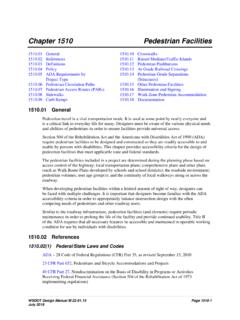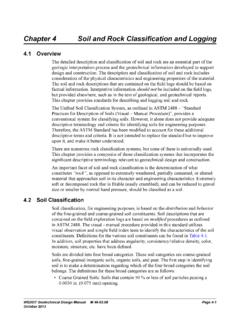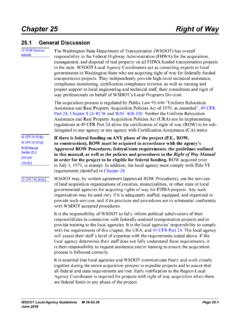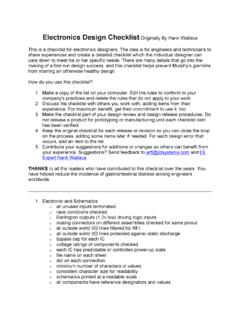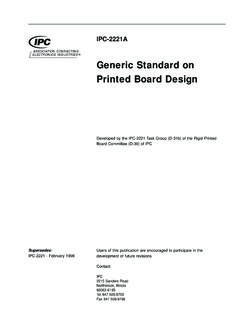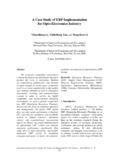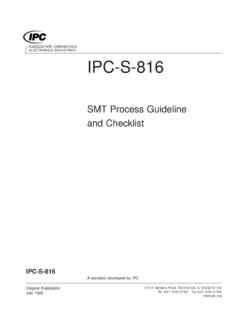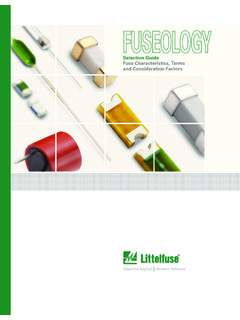Transcription of Chapter 41 General Project Types - wsdot.wa.gov
1 wsdot Local Agency Guidelines M Page 41-1 April 2017 Chapter 41 General Project General DiscussionThis Chapter identifies the design standards document, deviation approval authority, and design approval for a specific facility. The deviation process, Work Zone Safety and Mobility, and Intelligent Transportation Systems are also part of the manual is organized into six chapters relating to the design phase General design Information; City and County design Standards for Non NHS facilities; Location and design Approval; Plans, Specifications, and Estimates; State Advertising and Award Procedures; and Local Advertising and Award with Section 504 of the Rehabilitation Act of 1973 and the Americans with Disabilities Act of 1990 is required in the design , construction, operation and maintenance of transportation facilities ( , pedestrian facilities, park and ride lots).
2 Where sidewalks are provided, public agencies shall provide pedestrian access features such as continuous, unobstructed sidewalks, and curb cuts with detectable warnings at highway and street crossings. See 28 CFR Part 36, Appendix A, for minimum federal requirements for curb ramps. The design standards and deviation and design approval authority are shown in the following StandardsDeviation ApprovalDesign ApprovalInterstateNew/ReconstructionWSDO T design ManualWSDOT/FHWAWSDOT/FHWAITS Over $1,000,000 wsdot design ManualWSDOT HQWSDOT HQAll OtherWSDOT design ManualWSDOT HQWSDOT RegionNational Highway System (NHS)State Highways outside of incorporated cities, or on a limited access highwayWSDOT design ManualWSDOT HQWSDOT RegionState Highways within incorporated cities between back of curb to back of curbWSDOT design ManualWSDOT HQWSDOT RegionState Highways within incorporated cities beyond curb line*City and County design Standards See Chapter 42 wsdot Local ProgramsCityCity Streets (non-State highways)
3 *City and County design Standards See Chapter 42 wsdot Local ProgramsCityCounty Roads*City and County design Standards See Chapter 42 wsdot Local ProgramsCountyGeneral Project Types Chapter 41 Page 41-2 wsdot Local Agency Guidelines M April 2017 FacilityDesign StandardsDeviation ApprovalDesign ApprovalNon-National Highway Systems (Non-NHS)State Highways outside of incorporated cities, or on a limited access highwayWSDOT design ManualWSDOT HQWSDOT RegionState Highways within incorporated cities between back of curb to back of curbWSDOT design ManualWSDOT HQWSDOT RegionState Highways within incorporated cities beyond curb line*City and County design Standards See Chapter 42 wsdot Local ProgramsCityCity Streets (non-State Highways)
4 *City and County design Standards See Chapter 42 wsdot Local ProgramsCityCounty Roads*City and County design Standards See Chapter 42 wsdot Local ProgramsCounty*Bicycle facilities and multi-use facilities per RCW and must follow the current AASHTO bicycle design standards and/or standards submitted by the local agency which have been approved by Local Programs for any facility allowing bicycle standards apply to the design of new construction/reconstruction, 3-R (resurfacing, restoration, and rehabilitation), and 2-R (resurfacing and restoration). Each of these terms is defined in Chapter 42. Local agencies must determine which standards apply before beginning design .
5 See Chapter 42 for design standards on non-NHS Section for information on Value Work Zone Safety and Mobility All projects on the Interstate system must comply with 23 Code of Federal Regulations (CFR), Part 630, Subpart J: Work Zone Safety and Mobility and Subpart K: Temporary Traffic Control Devices. These rules apply to all federally funded projects advertised on or after October 12, 2007. It is recommended that any other federally funded Project over $10 million or any Project that includes a detour also apply the rules. wsdot design Manual M 22-01 Chapter 1010 has a list of requirements and key elements as well as checklist for developing a formal Transportation Management Plan (TMP).
6 A TMP is a set of strategies for managing the corridor-wide work zone impacts of a more information, please see wsdot Local Program s Work Zone Safety and Mobility page: 41 General Project TypesWSDOT Local Agency Guidelines M Page 41-3 April Intelligent Transportation Systems (ITS)Intelligent Transportation Systems (ITS) have the potential to reduce crashes and increase the mobility of transportation facilities. They also have the potential to enhance productivity through the use of advanced communications technologies and their integration into vehicles and the transportation infrastructure. These systems involve a broad range of wireless and wire line communications-based information, electronics, or information processing technologies.
7 Some of these technologies include cameras, variable message signs, ramp meters, road weather information systems, highway advisory radios, traffic management centers, and adaptive signal control technology (ASCT). ASCT is a traffic signal system that detects traffic conditions and adjusts signal timing remotely in response. More information on ASCT can be found on Local Programs Adaptive Signal Control Technology Web engineering is a typical part of any ITS Project development process. It is required on any federal aid Project that has an ITS work element, per 23 CFR Systems engineering is an interdisciplinary step-by-step process for complex projects such as ITS projects to: assess a system s needs and its relationship to the regional architecture.
8 Plan a Project that meets those needs and meets stakeholder needs and expectations. define other specific requirements for the Project /system. develop and implement the Project /system. define the operations and maintenance requirements for the system. plan for the refinement or replacement of the systems engineering on ITS projects has been shown to increase the likelihood of a Project s success. A successful Project is one that meets the Project scope and stakeholder/ Project sponsor expectations, is completed on time and within budget, and is efficient and cost effective to operate and level of systems engineering used for a Project should be on a scale commensurate with the scope, cost, and risk of the Project .
9 Complete the Intelligent Transportation Systems (ITS) Systems Engineering Analysis Worksheet in Appendix , or a document with the same information, for all federal aid projects that include ITS elements. Completing the worksheet will meet the minimum requirements in 23 CFR for systems engineering, determine the Project s risk, and determine if a more in-depth systems engineering analysis is shown in the worksheet, a more in-depth analysis requires that the following four documents be completed and used to implement the Project . These documents are produced as the result of the steps in the systems engineering process, often referred to as the V diagram, shown in Appendix Concept of Operations This document defines the problem, the Project s goals, stakeholder needs and expectations, constraints, and the way the ITS system is required to operate and be Project Types Chapter 41 Page 41-4 wsdot Local Agency Guidelines M April 20172.
10 System Requirements This document contains specifications of what the system is required to do, how well it is required to do it, and under what conditions. These requirements are based on the goals, stakeholder needs and expectations, constraints, and operation and maintenance requirements documented in the Concept of System Verification Plan This document describes how the agency will verify that the system being built meets the requirements in the System Requirements document. The agency will implement the System Verification Plan to ensure that all system requirements are verified before it accepts the System Validation Plan This document describes how the agency will assess the system s performance against the goals, stakeholder needs and expectations, constraints, and operation and maintenance requirements documented in the Concept of Operations.


